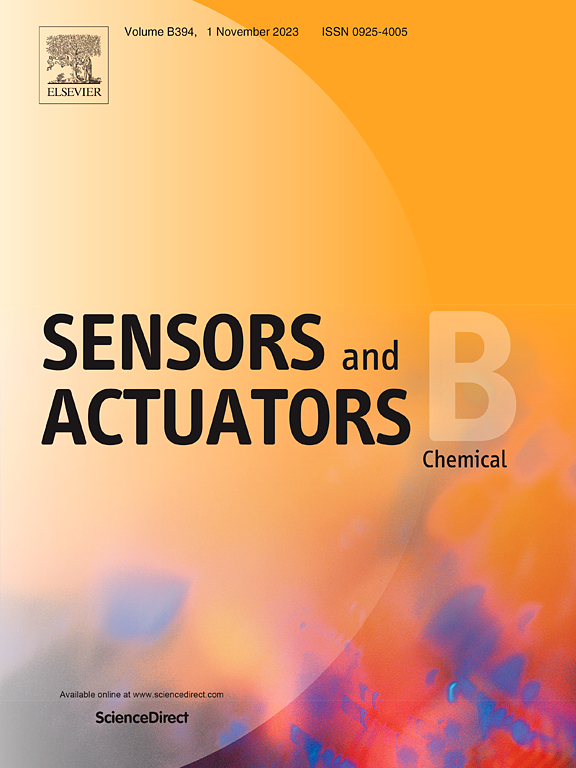探索剥脱六方氮化硼的室温氨感电位
IF 3.7
1区 化学
Q1 CHEMISTRY, ANALYTICAL
引用次数: 0
摘要
氨(NH₃)的检测对于确保工业工作场所的环境安全和保护人类健康至关重要。然而,其腐蚀性导致传感材料随着时间的推移而降解,以及室温传感器遭受湿度问题。六方氮化硼(hBN)是一种层状,化学稳定的材料,使其成为解决这些挑战的有前途的功能化传感材料。在这项研究中,hBN被合成并剥离,以制造在室温下表现出选择性NH₃检测的传感器,其检测限为百万分之90 (ppm),在180 ppm时响应为93%。为了进一步提高传感性能,用硝酸处理hBN,引入官能团,增加了NH₃的表面反应性和吸附位点。功能化的hBN基传感器对180 ppm的NH₃的响应率为225%,是原始hBN基传感器的2.5倍,并且将检测限降低到9 ppm,表现出优异的灵敏度。此外,它表现出优异的耐相对湿度(RH: 20%-80%)和220 天的长期稳定性。这种增强的性能是基于极性NH₃分子和极性hBN位点之间的强极性相互作用,这是由于功能化引起的,这已经通过原位傅里叶变换红外光谱(FTIR)研究得到了证实。该传感器可以在工业和环境环境中稳定,耐湿度的NH3监测中找到应用。本文章由计算机程序翻译,如有差异,请以英文原文为准。

Exploring the room-temperature ammonia sensing potential of exfoliated hexagonal boron nitride
Detection of ammonia (NH₃) is critical for ensuring environmental safety and protecting human health in industrial workplaces. However, its corrosive nature causes the sensing material to degrade over time, as well as room temperature sensors suffer humidity issues. Hexagonal boron nitride (hBN) is a layered, chemically stable material, making it a promising sensing material upon functionalization to address these challenges. In this study, hBN was synthesized and exfoliated to fabricate sensors that exhibited selective NH₃ detection at room temperature, with a detection limit of 90 parts per million (ppm) and a response of 93 % at 180 ppm. To enhance sensing performance further, hBN was treated with nitric acid, introducing functional groups that increased surface reactivity and adsorption sites for NH₃. Functionalized hBN based sensor exhibited a 225 % response towards 180 ppm NH₃, which is ∼ 2.5 times higher than that of pristine hBN based sensor, and lowered the detection limit down to 9 ppm, demonstrating superior sensitivity. Moreover, it demonstrated excellent resistance to Relative Humidity (RH: 20 %–80 %) and long‑term stability for 220 days. The enhanced performance is explained on the basis of strong polar-polar interactions between polar NH₃ molecules and the polar hBN sites induced due to functionalization which has been confirmed using the in-situ Fourier Transform Infrared Spectroscopy (FTIR) studies. The sensor may find application in stable, humidity resistant monitoring of NH3 in industrial and environmental settings.
求助全文
通过发布文献求助,成功后即可免费获取论文全文。
去求助
来源期刊

Sensors and Actuators B: Chemical
工程技术-电化学
CiteScore
14.60
自引率
11.90%
发文量
1776
审稿时长
3.2 months
期刊介绍:
Sensors & Actuators, B: Chemical is an international journal focused on the research and development of chemical transducers. It covers chemical sensors and biosensors, chemical actuators, and analytical microsystems. The journal is interdisciplinary, aiming to publish original works showcasing substantial advancements beyond the current state of the art in these fields, with practical applicability to solving meaningful analytical problems. Review articles are accepted by invitation from an Editor of the journal.
 求助内容:
求助内容: 应助结果提醒方式:
应助结果提醒方式:


